
Voltage Drop is a measure of how much voltage is lost in the cables between the consumer unit, the distribution board or some other reference point and the point of use. For example, we would like to know the Actual Voltage Drop in the shower cable from the house consumer unit to the shower unit, or from the consumer unit to the cooker connection point in the kitchen. We might even be installing a cable from the house to a garden shed or garage.
WHY DO WE WANT TO KNOW THE VOLTAGE DROP?
Why is it important to know the amount of voltage drop?
Well, if there is 230 volts at the consumer unit but only 220 volts at the cooker, where is the missing ten volts?

This voltage has been lost inside the cable (say twin and earth in this case) and this can give rise to a number of problems. The “lost” voltage is actually the voltage in the conductors, the cables and a combination of the lost voltage and the resistance of the copper conductors in the twin and earth cable will cause the cable to heat up. In the cooker example here, if the cooker was a 7kW model and drawing close to its full load of say 30 amps, then this ten volts difference equates to a loss of 300 watts in the cable. This is equivalent to five 60 watt bedside lights being lost in the cable.
Then there is the fact that there is a reduced voltage at the point of use. In this example there is only 220 volts available to heat up the saucepan of water so it will take longer to boil the water. If the cooker ring was rated at 1000 watts at 230 volts, then at 220 volts its output will only be 950 watts.
The 3kW oven would be affected by a greater amount. 3000 watts at 230 volts will be reduced to just 2850 watts at 220 volts a loss of 150W.
Finally, the voltage that is lost in the cables will still have to be paid for by the customer.
Voltage drop is a fact of life, it is not helpful and we should take steps to reduce it to a minimum. The Wiring Regulations give us a maximum difference that is permitted between the consumer unit and the point of use. An amount that is considered a reasonable maximum to “lose” in the cables.
For proper functioning of our circuits, we want to know that the Actual Voltage Drop does not exceed the Maximum Permitted Voltage Drop.
Table 1 of this article shows the maximum voltage drop values for a public low voltage supply – the National Grid – which is typical for almost the whole of the country and this is shown here …
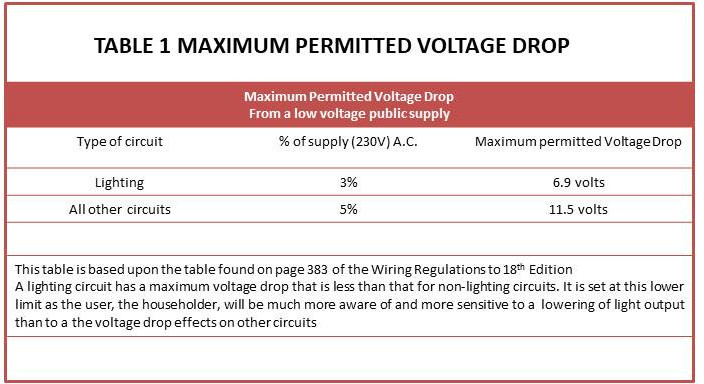
WHAT AFFECTS VOLTAGE DROP?
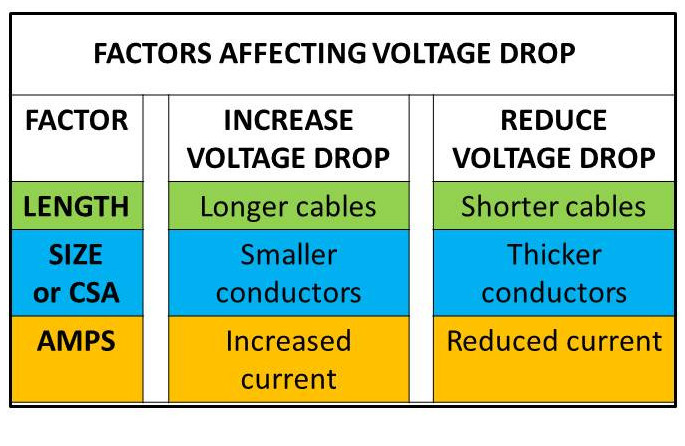
Many factors can affect the voltage drop in a cable.
LENGTH. Longer cables will have a greater voltage drop. Shortening a cable will lessen the voltage drop.
SIZE OF CABLE. Smaller cables will show more voltage drop than bigger cables.
LOAD CURRENT. An increase in current (Amps) in a cable will increase the voltage drop in the cable
What are these voltage drops that are being discussed, there are two and these are …
- the maximum permitted voltage drop as shown in Table 1 and we should try to not exceed this and
- the actual voltage drop which is a calculation of the amount of voltage that a particular circuit will lose in its conductors under certain conditions.
It is imperative that you be aware of which one is which
Every circuit will lose a certain amount of voltage in its cables for every amp that passes through the cables, and for every metre of its length. This voltage loss is given the symbol (mV/A/m) – millivolts per amp per metre – and the actual value of (mV/A/m) is given in the tables of the Wiring Regulations.
mv/A/m – How many millivolts are lost for every amp that flows through every metre of cable.
Here we are showing Table 2, the (mV/A/m) values to use for single phase circuits
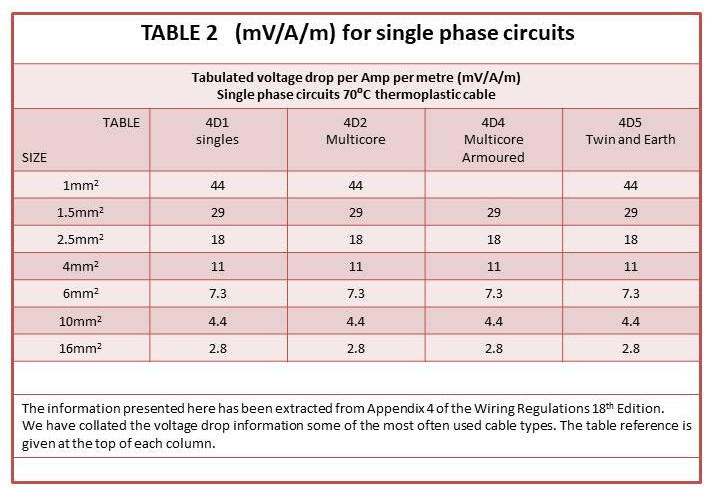
And here we show Table 3, the (mV/A/m) values for three phase circuits
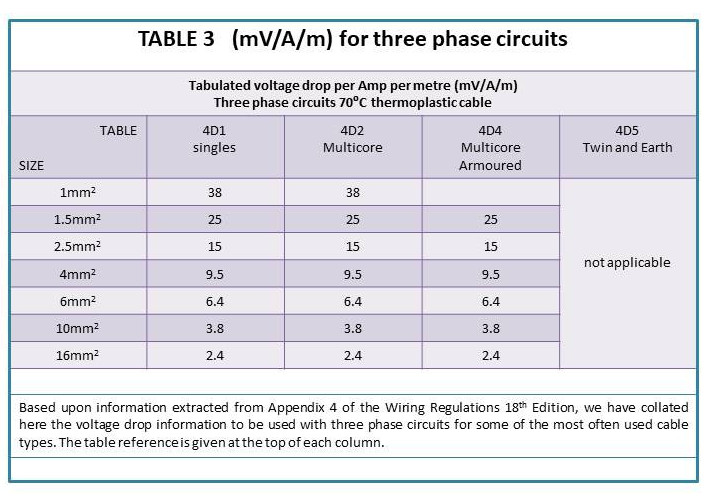
As the actual voltage drop will be calculated in millivolts (thousandths of a volt) and the maximum voltage drop is given in volts, it is necessary to divide the answer to the calculation by 1000 to convert it to volts for correct comparison of the two values, i.e. actual compared to maximum.
At the end of this post we have also listed some useful variations of the voltage drop formulas which may come in useful in the future.
VOLTAGE DROP – STANDARD FORMULA
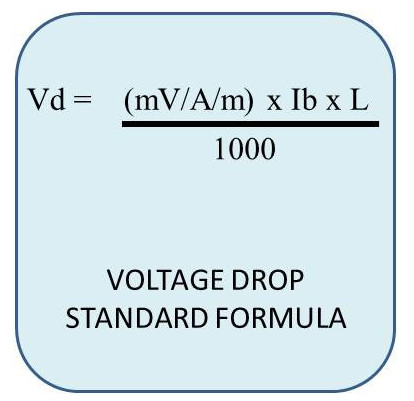
The formula shown is the most often quoted formula and is very easy to use.
The actual volts drop is calculated by
- finding the (mV/A/m) number from the relevant table for that particular cable type
- multiplying this by the maximum design current or load in amps of the attached equipment or the size of breaker if the design current is not known
- and then multiplying by the length of the circuit in metres from the consumer unit to the point of use
- and finally, this is then divided by 1000 to give the answer in volts.
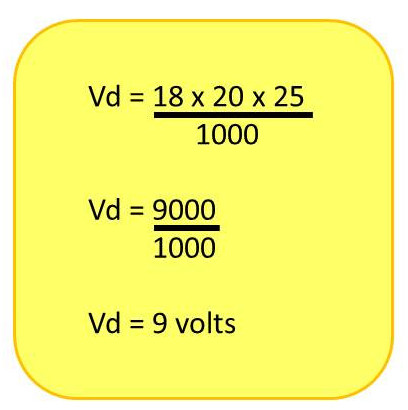
Example: if we wanted to know the volts drop for 2.5mm2 twin and earth cable for a single phase heater circuit that consumed 20 amps and had a circuit length of 25 metres …
- (mV/A/m) = 18 – from Table 2 above, for cable size and type
- Load Ib = 20 amps
- Length L = 25 metres
Performing the calculation we have an actual voltage drop of 9 volts for this circuit
VOLTAGE DROP – (R1+Rn) FORMULA
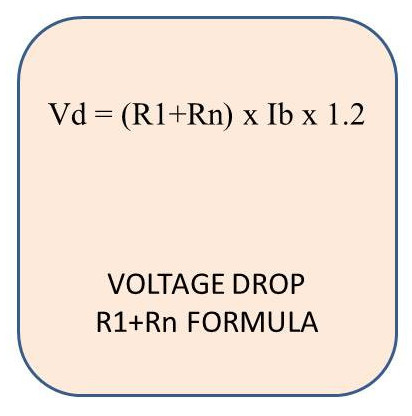
Using the same circuit as above we can consider how we might proceed during a periodic inspection or when certain information is not available. Let’s assume that we don’t know the length of the cable run and that we don’t know the (mV/A/m) number for the cable.
We can, in this case, carry out an (R1+Rn) measurement. We do know that the heater draws 20 amps from the rating plate on the heater cabinet. We will need to measure the resistance of the phase and neutral conductors and we will carry out this test as a dead test. So, after safely isolating the circuit we can link the Phase (R1) and the Neutral (Rn) together at one end, say at the consumer unit, and measure the open lead resistance of the two lengths combined at the other end, the heater end.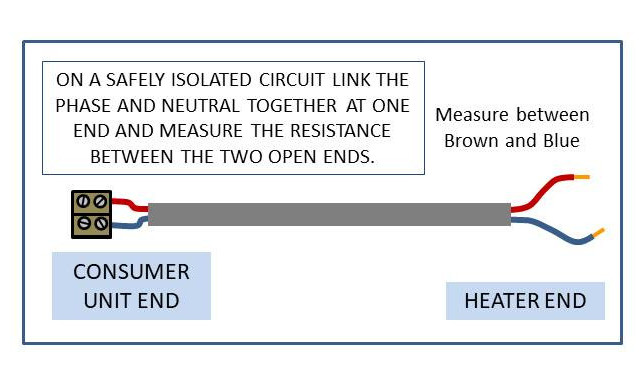
This will give us the combined reading or (R1+Rn) and for this example let us say that this is 0.371 ohms.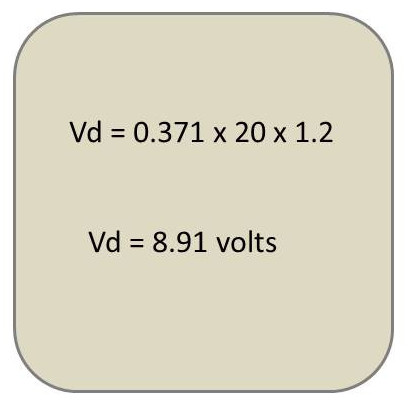
We now have …
- Measured (R1+Rn) = 0.371Ω
- Ib = 20 amps
- Temperature correction factor at full load = 1.2 (the 80% rule)
This calculation gives us a voltage drop of 8.91 volts
This is basic Ohm’s Law – Resistance multiplied by Current multiplied by the temperature factor.
You can see that these two different methods, on the same circuit, give the same result within acceptable tolerances.
USEFUL VARIATIONS OF THE FORMULA
We show here the five main transformations of the volts drop formula that we at Learn Electrics find the most useful. We begin with the standard formula that everyone should know. If you are taking your Wiring Regulations exam (18th Edition) then you may be fairly certain that a question will come up on the standard formula for voltage drop. It is one of the favourite questions.
This is followed by the R1+Rn formula that we have just calculated, and then three more variations to allow you to calculate different parameters of the cable – the maximum length, the maximum current and the minimum size of conductor.
STANDARD FORMULA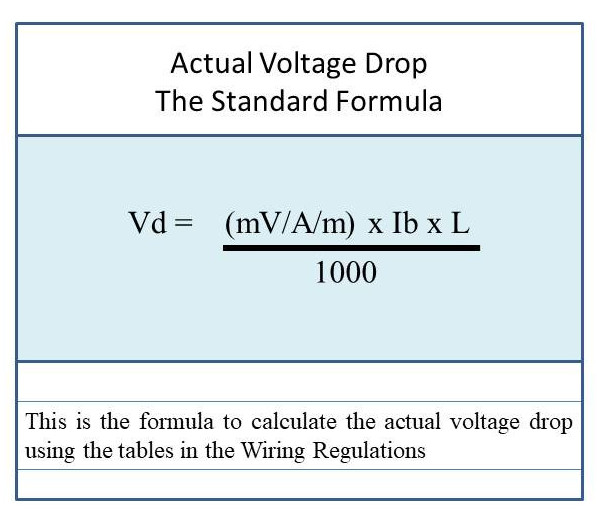
R1+Rn FORMULA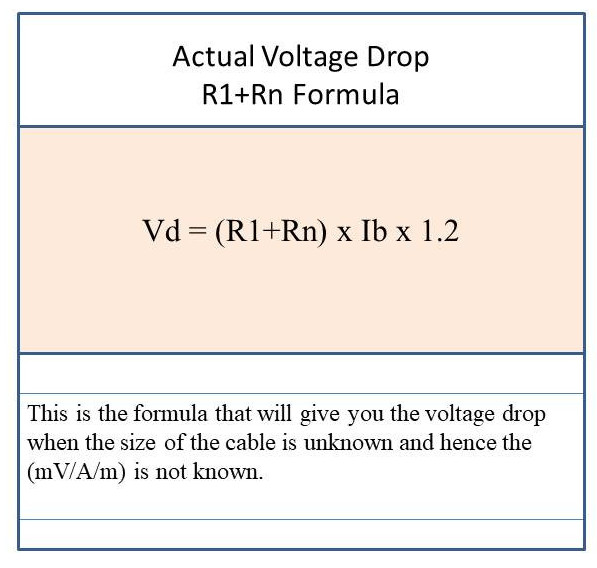
MAXIMUM LENGTH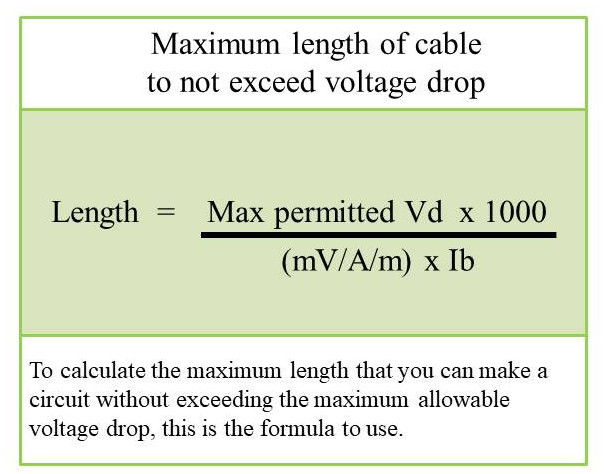
MAXIMUM CURRENT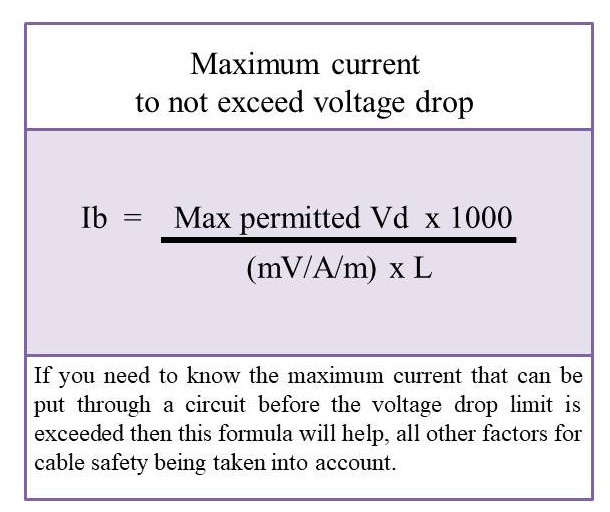
MINIMUM SIZE OF CONDUCTOR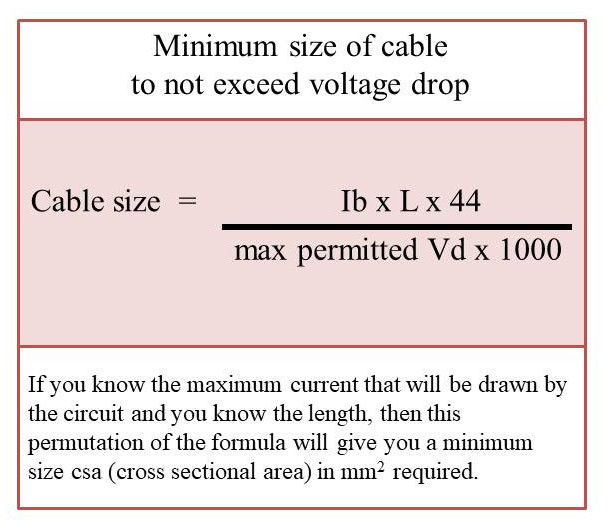
________________________________________________________________________________________
We hope that you have found this article useful. With all electrical formulas, the secret to being good at the calculations is to practice them at home or in the office, before you need to use them on site.
Although we have stated here “maximum permitted” values, the Wiring Regulations are non-statutory; in other words, they are a code of practice – a recommendation for good working practice. Our policy is to always follow the criteria given in the Wiring Regulations. Someone has sat down and worked out the best practice for safety, efficiency and compliance with the Electricity at Work Regulations and the various standards applicable to our trade. We should always strive to comply with that guidance.
We also have a very active YouTube channel.
Type in LearnElectrics all one word, into the YouTube search bar and you will have access to all our videos on many electrical topics.
There is a companion video to this article on YouTube which can be found by putting the following link into your web browser.
https://www.youtube.com/watch?v=ej3-6wcHfkE
Thank you for viewing
David
